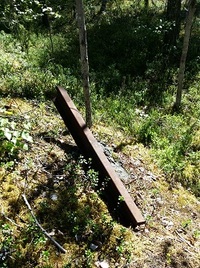This camp was definitely not a holiday camp. A published report about German Penal Camps in Finland, 1941-1944, Prisoners of war and forced labour – histories of war and occupation (The Falstad symposium 20.-21.November 2008, Lars Westerlund), tells about a insane brutality and harsh conditions: "Local inhabitants remember the brutal treatment that the convicts were subjected to. In the fall of 1942, two frightened Germans – fugitives from the camp – came to the house of Isonaho in Kivivaara; they were soon followed by the search party, led by a major. One of the fugitives managed to jump out of the window and flee into the forest, but the other was shot while trying to climb out, while the inhabitants of the house looked on. Penal soldiers could be shot for even minor infractions. The first one was shot directly after they arrived in the courtyard of the school at Metsäkylä. As the soldiers stood in a soup queue, one of them tried to jump the queue: he was immediately moved to the side, and shot. The body was buried beside the school gate, but at the request of one of the teachers, it was moved about two hundred metres to the north, to a spot which became the cemetery for the penal soldiers. The group of SS-men that were in charge of maintaining order in the camp had a barracks between the school and the house of Vanhala."
The Finnish author Kalle Päätalo has, in his novel Nälkämäki (Hunger Hill), described how the Germans founded in the summer of 1942 a camp for their penal soldiers in the yard of his uncle and namesake, Kalle Päätalo, factory manager at Kumpu, at Isonummi in Taivalkoski: "The Germans built a barrack village and barbed wire enclosure at the edge of the field. Most of the penal soldiers were German political dissidents, but there were also some actual criminals among them. The soldiers did not have adequate clothing, and what they had consisted mostly of rags. The prisoners felled, dragged, and carried logs with their bare hands, as most of them lacked gloves – despite the fact that temperatures in January 1943 exceeded -30 degrees Celsius. The dead were buried without grave-markers or blessings, and the living were denied the comfort of hearing the Word of God.
There is also an article about this railroad in Vaino Linna's book "Unknown Soldier" (Tuntematon Sotilas). When works started 1st July 1942 there were 340 POW's and 1 German construction battalion available. At peak there was some 3500 men at work.1/3 of them were Germans plus 400 work liablies mainly from Poland, 50 trustees prisoners and 1800 Soviet POW's. The POW's were mainly Ukrainians and Kirghiz captured in the South Russian summer 1942. At start there was also 2 German Penal companies in work, some 900 men. About 1000 men died while building 178 km long railroad.
After the war both the Russians and Germans went to Metsakyla to bring back their dead people. They have to dig them up again. The Germans brought back all their dead people. Most bodies from the dead Russians where brought to Rovaniami for a grave there. It`s believed that Russians bodies are still buried around in the area. He pointed at one place where he believed there could be a mass grave. Not all soldiers become buried properly here during the war. Our guide told us about that after the war children found a shoe sticking up from the ground, and when they started digging, they found a body.
The Death Railway - The backround for this prison camp:
Kenttärata - railway of the 2nd World War (source: Taivalkoski Tourist Information)
The Germans built a 178 km long railway with narrow gauges from Hyrynsalmi to Kuusamo during World War II. The builders were mainly Russian and Polish prisoners-of-war and German political prisoners.
In autumn 1941, the German army began to prepare for war on the Eastern Front and launched Operation Barbarossa by cutting off the Murman Railway. The wintry conditions, however, caused extensive maintenance problems. The surprisingly intense Soviet resistance, tundra and forest terrain stopped the army from advancing. An insufficient amount of vehicles and fuel added to the maintenance problems in northern Finland. To facilitate the maintenance of the German troops, a trench railway was built.
The construction of the trench railway had begun months before the official trench railway agreement was signed on 3 September 1942. Spanning a distance of 178 km between Hyrynsalmi and Kuusamo, the narrow gauge railway of 750 mm in width was a remarkable construction project. By summer 1944, the Hyrynsalmi–Kuusamo railway comprised 208 km of operating railway, including branch terminal lines, which was about 11 % of all of the railways constructed by the Third Reich. There were also plans to continue the trench railway to Kiestinki, but that plan was never carried out. The railway was inaugurated on 13 January 1944, only to be destroyed 242 days later in September of the same year.
About 19,000 Soviet prisoners of war died in Finnish prison camps during the Continuation War, which means that about 30% of Soviet POWs taken by the Finns did not survive. The high number of fatalities was mainly due to malnutrition and diseases. However, about 1000 POWs are believed to have been executed (source: Wikipedia).
So what about the Finnish responsibility?
As told by my guide, there were several Finnish factories located near the prisoner camp. These were suppliers to the camp and the construction of the railway. The two largest suppliers were Puutalo Oy and Kupittaan Savi Oy. It was a huge building here where they constructed and maintained locomotives, wagons and tracks. It`s still possible to observe the bolts on the ground from the building.
The Lapland War was fought between Finland and Nazi Germany in Lapland, the northernmost part of Finland. The main strategic interest of Germany in the region were the nickel mines in the Petsamo area. Finland was an unformal allied with Germany but only to get back the land they lost to the Soviet Union during the Winter War. When Finland made peace with the Soviets, they made war against the Germans to drive them out of their country (the Lapland War).
The Finns did not pay much attention to the living conditions of the Soviet Prisoners of War (POWs) at the beginning of the war, as the war was expected to be of short duration. The quantity and quality of camp personnel was very low, as the more qualified men were at the front. It was not until the middle of 1942 that the quantity and quality of camp personnel was improved. There was a shortage of labour in Finland and authorities assigned POWs to forest and agricultural work, as well as the construction of fortification lines. Some Soviet officers cooperated with the Finnish authorities and were released from prison by the end of the war (source: Wikipedia -Soviet prisoners of war in Finland).
Here is an extract from the report Prisoners of War and Internees, A Book of Articles by the National Archives, Lars Westerlund:
"With regards to international law, Finland was responsible for those cases of abuse and inhuman treatment perpetrated against Soviet POWs during the Continuation War, as well as for the mass mortality among POWs in the period of 1941–42, as far as it was caused by the neglect of the basic needs of the inmates. Finland can also be considered to have a certain responsibility for the German maltreatment of POWs – including severe corporeal punishments and occasional executions – in the North, since Finland was a partner of Germany, and allowed the Germans to use Finnish territory and infrastructure in operating POW slave labour projects. Finland also handed over some Soviet POWs to the Germans without always asking the POWs for permission, or setting any conditions whatsoever on the treatment of the inmates. However, on the whole, the Finnish authorities paid little or no attention to these issues, as the proper management of the Soviet POWs in Finnish custody caused the authorities more immediate concerns, and turned out to be an almost insurmountable task – in glaring contrast to the situation during the Winter War of 1939–40. Especially during the initial period of the war in 1941–42, Finland did not in the least succeed in following the guidelines and directives on the proper treatment of POWs set out in the Hague Convention of 1907 and the Geneva Convention of 1929, even though the high instance of deaths among POWs was unintentional. As mass mortality and maltreatment were rampant in the Finnish POW camps, it is not surprising that the policies of the Germans on POWs, which were in some regards laxer and in others more severe, were accepted. Due to bad international publicity in Denmark, Sweden, Switzerland, Great Britain and the US, the Finnish headquarters chose in 1942 to improve conditions on POW camps, which, although still haltingly, better corresponded in 1943–44 to the standards of the international conventions. However, the Finnish authorities consistently considered the treatment of Soviet POWs in German custody to be an internal issue of AOK 20, and apparently no efforts were made to improve the treatment of these POWs".
By turning the spotlight on the Korvua Camp and other prisoner camps in Finland, the Finnish might need to revise the story of what really happened there during the Second World War.
Not forgotten
It`s incredible how some people managed so big efforts, handling the brutalness of the guards, starving, coldness and the same time building a so long railway just with their own bare hands. They are the real vanished heroes and should not be forgotten. The railway was a huge construction wonder, a great logistical achievement and very became strategically important in the war. This achievement shape how we perceive and understand the past, and make an important contribution to the knowledge and understanding of the camps.
New tales will take wing and legends will come to life.
Stein Morten Lund, 14th July 2014
Additional information
Sources:
A published report about German Penal Camps in Finland, 1941-1944, Prisoners of war and forced labour – histories of war and occupation, The Falstad symposium 20.-21.November 2008, Lars Westerlund.
SOTAVANGIT JA INTERNOIDUT, Kansallisarkiston artikkelikirja
Lars Westerlund (toim.)
Prisoners of War and Internees
A Book of Articles by the National Archives
Lars Westerlund (ed.)
Forgotten in the Wilderness: WWII German PoW Camps in Finnish Lapland, Oula Seitsonen
This collection of articles, published by the Finnish National Archives, deals with issues relating to Prisoners-of-War and internees primarily during World War II. Fifteen scholars from Finland, Norway, Germany, Poland, and Russia examine different aspects of the capture, treatment, ethnic backgrounds and repatriation of POWs and internees.
Wikipedia - Finnish War History
Taivalkoski Tourist Information - Read about the background history for the Korvua Camp and several routes where the railway was built.












